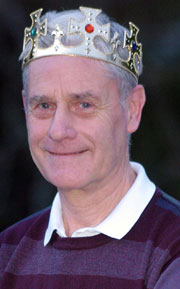Meet 'King' Albert
Feb 9 2007 By Daniel Thomson, The Journal
 When Albert Turnbull began looking into his family history he never dreamed of discovering that he was related to the King of England.
When Albert Turnbull began looking into his family history he never dreamed of discovering that he was related to the King of England.But the retired engineer, of Whickham, Gateshead, was named yesterday as having one of the strongest claims on the throne, after English Heritage carried out an international search for alternative heirs.
Albert has known about his regal ancestry for more than 15 years, but stepped forward to reveal his family's lineage when he heard of an appeal to track down the relatives of those who might have been crowned if William the Conqueror had lost the Battle of Hastings.
Grandfather-of-four Albert started researching his genealogy 35 years ago and was shocked to discover he was not only related to St Margaret and King Alfred - but also to William the Conqueror.
This means Albert may have had a claim on the throne regardless of the result of the Battle of Hastings. Albert, the Prince of Wales's 23rd cousin, said: "I managed to go all the way back to King Cerdic,[correct] the first King of Wessex, who invaded Britain in about 500AD. The Royal Family can trace its line back to King Cerdic and I'm 55 generations descended from him.
"I was quite shocked when I discovered this meant I had a claim on the throne, but I don't take it too seriously. I've got no delusions of grandeur. Theoretically, everyone alive now who had ancestors in Britain has some sort of claim.
"And I don't think Prince Charles is going to be looking over his shoulder anytime soon."
The retired lecturer and engineer became interested in tracing his family history in 1972 after reading a story about William of Rule who was reportedly re-named Turnbull after saving Robert the Bruce from a rampaging bull.
He was able to trace the family to Henry Turnbull who bought land in Elswick, Newcastle, from the Barony of Benwell in the 1500s. This land was later identified as Turnbull's Nook.
But it took 20 years of detective work for Albert to discover he was related to royalty.
He said: "Most people can only trace their family history back to about 1600 because that's how far church records go back, but if you can find a landowner you can go back much further.
"I was lucky enough to discover my father's grandmother was called Thirkeld and originated in Cumbria where they married into the Barons of Westmorland. This meant I was related to the 10th Baron, who could be traced back to King Edward III in the 1300s.
"I managed to go back even further to King Cerdic in 500AD using the Anglo Saxon Chronicles, but I can't go back any further than that, although I can still go sideways, so my search isn't over. I've come to really love it. It's detective work."
Albert is married to Rita, 67, and they have children, Hayley, 42, and Ian, 38, and four grandchildren: Rachel, 14, Alex, 10, Emily, 10, and seven-year-old Lucy.
Albert worked as an engineer building coaches before lecturing in both engineering and genealogy, at Gateshead Technical College for 34 years.
1066 and all that made the difference
If William the Conqueror had not won the Battle of Hastings the Royal family would look very different today.
The conflict over the rightful heir to the English throne began in 1066 following the death of childless Edward the Confessor.
His great-nephew Edgar the Aetheling, known as the "lost king" of England, was chosen to succeed him, but was never crowned.
Edgar was a direct descendent of Alfred the Great, but because he was only 10 years old he was not considered to be experienced enough to defend England against Norman and Viking invasion.
Nobleman Harold Godwinson was chosen instead, becoming King Harold II, but immediately came up against a powerful rival when William the Conqueror invaded.
His victory at the Battle of Hastings, saw Harold famously killed by an arrow through the eye, as William took the throne.
William's place in English history is momentous and his descendents have ruled the nation ever since.
Battle plan prompts crowning quest
English Heritage launched its appeal for alternative heirs to the throne to mark the opening of a £2.3m visitor centre at the site of the Battle of Hastings.
More than 500 people came forward with claims and about 150 were shortlisted from the US, France, Italy, Norway, Sweden, Australia, Canada, and Holland.
They had to prove they had a link to either King Harold, Edward the Confessor, Edgar the Aetheling or Alfred the Great.
English Heritage found retired engineer Albert Turnbull, 70, of Whickham, Gateshead, and Mark Golledge, of Berkshire, had two of the strongest claims. Both men had strong links to King Alfred.
Dr Nick Barratt, of BBC's Who Do You Think You Are? series said they had also examined St Margaret of Scotland, who was one of Albert's relatives, as being a key to a Royal lineage.
He said: "A direct descendant of Alfred the Great, she was related to both Edward the Confessor and Edgar the Aetheling. If people can trace their lineage back to St Margaret they're well connected to two of the key players whose roles are explored in the interactive exhibition in the new centre."

































.jpeg#joomlaImage://local-images/tcalibrary/museum/vmpeople/John%20I%20Turnbull%20(Jack).jpeg?width=960&height=1169)







.jpg#joomlaImage://local-images/tcalibrary/museum/vmpeople/Malcolm_Turnbull_PEO_(cropped).jpg?width=656&height=960)

















